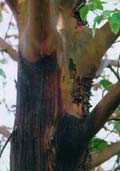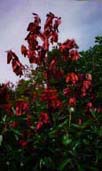Pacific Madrone Health


Pacific madrone (Arbutus menziesii) is a broadleaf evergreen tree with red scaly bark. It is subject to a variety of diseases andinsect pests. For more information, consult students.washington.edu/melliott/arbutus/Arbutus.html
Nattrassia mangiferae is a stem and branch canker fungus that is the main reason for the poor health of many Pacific madronetrees. The fungus invades heat injured bark when branches are exposed to strong sunlight, and also through wounds made by pruning or other mechanical damage. Damaged wood is blackened and cracked longitudinally. The area may be sunken or have a raised callus margin. The branch or trunk becomes weak at the site of the canker and may crack off.


Fusicoccum aesculi is a fungus that causes a branch dieback in madrone. It usually works in conjunction with other canker fungi such as Nattrassia. It begins at the branch tips, moving inward. The bark is dark red, turning black and looking burned after the branch is dead. This fungus does not attack vigorous trees. Its hosts are trees that are weakened by other canker fungi or are under water stress. Fungal growth stops when the host receives sufficient water.
Madrone leaves a common target for foliar pathogens because they are rich in sugars and stay on the tree for two years, longer than the leaves of most deciduous trees. New leaves emerge in summer, but are not usually infected until fall. Foliage diseases cause conspicuous leaf drop, spotsand browning, but are rarely a threat to the survival of the tree. The amount of inoculumcan be reduced by removing dead leaves and pruning infected trees. Rake and remove fallen leaves in the late summer or early fall.
Madrone is also susceptible to snow and ice storm damage. Branches fail when the leaves capture heavy snow loads.